Crew 281 GreenHab Report 22 May 2023
GreenHab Officer: Megan Kane
Environmental control: mixed door open/ door open with fan
Average temperatures: 87.78 °F
Hours of supplemental light: None
Daily water usage for crops 2.25 gallons
Daily water usage for research and/or other purposes: 0.4 gallons
Water in Blue Tank 161.12 gallons
Time(s) of watering for crops:
0720: refilled 5 water bottle (2.5 L) watered other plants as needed 3.0 L
1813: refill 3 water bottles (1.5L) and watered other plants as needed 1.5L
Changes to crops:
Tomatoes and cucumbers almost ready to harvest.
Narrative:
In the morning the GreenHab was checked and watered. The cooling cloth’s reservoir was also refilled. The temperature was checked several times. The highest recorded temperature today was 102.7.
Harvest: (include which crop and mass in grams): None
Support/supplies needed: None
EVA Report – May 22nd
Crew 281 EVA Report 22-05-2023
EVA # 9
Authors: Megan Kane (Commander), Ritupriya Patil (Executive Officer), Ana Pires (Crew Scientist)
Purpose of EVA:
Conduct Geotechnical Survey of the area and geomechanical assessment
Schmidt Hammer and Equotip measurements along scanlines
Geological and geotechnical assessment of the scanline using the created datasheet by the Crew Scientist
Acquire images and collect loose rock/soil samples
Drone flight to record all of the above operations and do aerial imagery
Start time: 0834 hrs
End time: 0939 hrs
Narrative:
At 0801 the three members of the EVA entered the airlock exiting at 0807. They first checked all the rovers and collected their information. Hours and State of Charge were recorded for each vehicle and it was verified that all were securely plugged in. They then unplugged Spirit and Perseverance in preparation for heading out to Pooh’s Corner (Site). They left at 0814.
EVA Crew arrived at Site 0823. After parking the rovers the crew did a visual survey of the area to locate a good location for the scanline. At 0806 the crew conducted a water break. They chose the location and laid the scanline. Measurements commenced at approximately 0834. There were 5 stations total. See the completion times below:
Station 1 complete at 0838.
Station 2 complete at 0851
Station 3 complete at 0858
Station 4 complete at 0906
Station 5 complete at 0910
Water checks were taken approximately every half an hour. Samples were collected near the scanline after station 5 was complete. When station 3 began at 0840 drone setup was started. Drone was launched at 0840. The wind was very high and the drone was unable to complete the planned shots. The drone landed at 0900.
At 0919 the crew headed back to the rovers. At 0922 they started back to MDRS in rovers arriving at 0930. The crew re-entered the airlock at 0934 and the hab at 0939.
The crew did not stop over at Marble Ritual for drone footage due to high winds.
Overview of EVA
Drove to Pooh’s Corner
Completed a scanline
Took drone footage for georeferencing
Issues Experienced During EVA
Comms issues throughout. We expect this is due to the high inference on the bands from the current space weather.
Winds too high to get all desired imagery.
Outcomes
Crew completed Rover checks
Crew drove to Pooh’s Corner Ridge
Crew Completed Geological survey
Drone footage of survey area at Pooh’s Corner collected
Collected 6 rocks, 936 g; 1 tube of soil, 49 g
Coordinates (use UTM WSG 84): 519025 E, 4251183 N
EVA Participants 3: Ritupriya Patil (XO, EVA Lead, KC Shasteen (Crew Engineer), Ana Pires (Crew Scientist)
Road(s) and routes per MDRS Map: Drive on Cow Dung Road and walk east until Pooh’s Corner.
Mode of travel: Rover
Crew Photos – May 21st
Research Report – May 21st
[category science-report]
Crew 281 Mid-Mission Research Report
Date: 05/21/2023
Introduction
The team is halfway through the 14 day mission. No plan survives contact with reality; however, the Pegasus Crew has made steady progress on all of their research goals. Each crew member has provided an update on their research and activities in their own words.
-
Megan Kane: Commander and GreenHab Officer
-
Ritupriya Patil: Executive Officer and Crew Scientist
-
Rachel Jones: Health Safety Officer and Journalist
-
Ana Pires: Crew Scientist
-
KC Shasteen: Crew Engineer (editor)
Each day has been an adventure with new learning experiences and activities. Most days there has been 1 or 2 Extra-Vehicular Activities (EVAs).
Research and Activities Updates
Megan Kane – Commander and GreenHab Officer
Three main projects have been worked on outside of the daily activities of keeping the crew and mission running.
Cacao (Chocolate) Seed Propagation.
The science dome has a grow tent that is being used for the cacao seed propagation. So far, the following steps have been completed:
-
Seed pods opened and seeds removed
-
Seeds cleaned
-
Seeds laid out for germination on trays with moist paper towels
-
Clean seeds a second time and replace paper towels
-
Transplant all seeds that have sprouted roots into pots
It is anticipated that in the next few days the first 2 leaves (cotyledons) will be visible. The temperature and humidity of the grow tent is being recorded.
GreenHab Usability Extension
The GreenHab does not usually run this late in the season. With the assistance of the Crew Engineer, KC Shasteen, several simple changes are being tested to extend the usability of the GreenHab. These include:
-
adding an airflow diverter to keep the fan from blowing directly on the plants. Doing so causes excessive drying of the plants if the airflow is too strong
-
testing low tech methods to improve airflow and humidity
The airflow diverter designed and fabricated by KC has 45 degree slats which push the air from the fan up and over the plants. It greatly increases the airflow throughout the GreenHab by creating a circulation air from the fan across the ceiling and down the rear wall. Added to this is a spacer that holds open the louvers on the airflow exit vent, which allows a chimney effect to draw additional air across the GreenHab from the door to the vent. This spring-loaded vent would normally open from over-pressure when the fan is on and the door is closed. However, based on the recommendation of MRDS Mission Support the door was left open for airflow and cooling. Combining the open door with the open louvers creates a cross breeze inside of the GreenHab which decreases the temperature and relieves heat stress on the plants.
Passive Irrigation System
The passively pumped irrigation system was installed on Sol 1 in the GreenHab. There are 10 planters which now receive their water using terracotta watering spikes. The consumption of water is being tracked for the control planters (water by manual pouring) and the test planters (water using the terracotta spikes). After the mission the watering data will be analyzed to see if there were any statistical differences.
Ritupriya Patil: Executive Officer and Crew Scientist
Behavioral Studies Research:
The 7 Sols spent on the red planet have been an exhilarating experience. A strong sense of camaraderie and teamwork permeates the crew, as they assist one another in accomplishing research objectives and maximizing the mission’s potential. The MDRS mission for crew 281 has provided us with a fresh perspective in preparation for future Mars expeditions. From adhering to morning rituals and preparing meals using freeze-dried food to practicing water conservation and prioritizing each other’s safety, the crew has demonstrated our dedication. We have also actively engaged in engineering solutions and research endeavors to optimize their time at the MDRS. Additionally, I have participated in the MDRS Behavioral Study program, collaborating with the University of Central Florida. This opportunity has granted valuable insights into the role of emotions within Isolated, Confined, and Extreme (ICE) environments. During the stay at the MDRS, contributions are being made to the behavioral studies research by providing daily logs and surveys, thereby assisting in the accumulation of data.
Crew Scientist Research – Investigation of Drone Technology for Georeferencing and Emergency Assistance
The focus of this research is to examine the potential applications of drone technology in supporting astronauts during Mars surface exploration while emphasizing the importance of astronaut safety during extravehicular activity (EVA). The objectives include georeferencing, route planning, emergency medical assistance, and documentation of EVA activities.
To achieve the first goal, research work was done in collaboration with Ana Pires (Crew Scientist) and KC Shasteen (Crew Engineer). To aid Ana Pries’ rock hardness testing and scanline measurements for the chosen boulders under study, detailed vertical and diagonal drone footage was captured for each scanline. These images and videos will help confirm the weathering grade and discontinuities of the rocks. Various drone flying techniques were explored and successfully recorded the scanline footage. High altitude (below 120 m) imagery was captured to georeference the MDRS and surrounding region.
The second objective was achieved by performing a drill EVA mission around the Hab with an emergency scenario simulating an injured astronaut being delivered a lightweight emergency kit. The first proof of concept experiment established a baseline, more work will be done over rest of the mission to deliver at longer ranges and using more efficient routes.
For the final objective, drone footage documentation has been contributed to 4 of the 8 EVAs so far. The plan is to continue collecting videos and images for crew research and outside Hab activities, as needed, for the remaining EVAs. The total drone flight time so far is recorded to be 1 hour and 45 minutes.
The acquired data and insights have the potential to significantly contribute to the advancement of knowledge and understanding in the field, ultimately facilitating safer and more effective exploration of the Martian landscape.
Pictures above starting clockwise from top left
-
Aerial shot of the MDRS campus captured via drone
-
Deploying the drone for first time on MDRS campus to get georeferencing footage.
-
Working on the payload harness for drone to deliver during the drill
-
Kissing Camel Ridge captured on drone during our 6th EVA
-
Drone returning after dropping the payload to simulate emergency medical assistance.
Rachel Jones: Health Safety Officer and Journalist
Re-Establishing Amateur Radio Communications
In October 2022, before the start of the 2022-2023 MDRS season, an amateur radio station was established at MDRS. The station was designed by 16-year-old Hope Lea (ND2L). She set up the station as part of NASA sponsored Spaceward Bound Utah, which featured the first all high school crew at MDRS.
The station comprised of a Shack-in-the-Box set up containing an I-Com 7300 radio, LDG Tuner, and an external speaker. The Shack-in-the-Box, which is a name brand many amateurs might call a go-box, is then either connected to the wall outlet or a battery for power. The battery configuration allows a station to be ran both on-the-grid or off-the-grid as a possible POTA (Parks-on-the-Air) station. The kit holds two coax cables, likely for redundancy, as only one is needed to connect the go-box to the antenna. The station uses a versatile Chameleon High Frequency (HF) Modular Portable Antenna System 2.0 which has nine different configuration possibilities.
After an inventory of the station (Sol 4), practice configuration, and team deployment training (Sol 5), the station was finally set up on Sol 6.
Rachel deploys and operates the MDRS amateur radio station.
Ana Pires: Crew Scientist
Narrative:
One week ago, Ana had the opportunity to see the Mars Desert Research Station for the first time and to “breathe” on Mars! She woke up early every day to watch the sun starting to shine in this wonderful and unique geological setting. As a researcher and a geoscientist, she will carry all these colors in her memory for all her life! However, she is on Mars, so everything must be planned with the Commander, the team, and the mission support.
Geosciences, geotechnics, and technology on Mars is hard. Ana’s research includes a geological-geotechnical assessment of the area (using scanline surveys adapted from ISRM, 1981), as well as a geomechanical characterization of the rock hardness using Equotip and Schmidt hammer (non-destructive testing equipment). The research also includes the testing of a rock sampling device (scoop prototype) in a real environment and the registration of possible future adjustments.
The Crew Scientist is collaborating with Portuguese researchers involved in the field of engineering materials, so the Crew was able to wear T-shirts and boxers (Smart Textiles) designed for extreme environments, during their EVAs. The feedback is positive, and the team has already provided a lot of suggestions and recommendations to improve the design.
The Crew Scientist has been producing a series of educational & outreach videos about her time spent on our Utah campus for students in Portugal, under the scope of “Space For All Nations Initiative” (run by International Institute for Astronautical Sciences) and also for her project “Portuguese GeoTech-Vision for STEAM Outreach and Education”.
Human relationships are an important part of this mission and were also part of her personal learning at the MDRS. Listening to the Commander, Megan Kane, talk about her stories in Africa, or speaking Chichewa language, her dogs, her passions… Ritupriya Patil (Executive Officer) the serenity that we need during these days on Mars, Rachel Jones (Crew Journalist and HSO) a force of Nature offering us the boost that we need to “survive”, and finally KC Shasteen (Crew Engineer), which offers us generosity and intelligence.
Ana is eager to know more about this awesome Team. The mission is still ongoing… The Crew Scientist will continue listening to the sounds of Mars, breathe Science and Technology, knowing that the MDRS will be forever in her heart.
Crew 281 activities
The week included several EVAs with the Crew Engineer and XO, where it was possible to adapt for the first time to wearing the spacesuits, handling items with gloves, driving the rovers, performing all the proposed tasks with a mind for safety, and readjusting the methodology used during the geotechnical assessment. Mars is testing the Team Pegasus every day and pushing it to the limit. The passion for Science and Technology really overcomes all the challenges that the Crew faced this first week.
MDRS Analog Mission in 2 words: adaptation and “saudade” (Portuguese word)
The research in numbers: Three scanlines; total length of scanline 65 m; 14 stations; 2 types of equipment for rock hardness; 2 humans; 700 measurements; > 5kg rock samples; > 200g of soil samples; 1 test with the rock sampling device (named “Pegasus” scoop); > 1500 images and videos acquired.
Next steps: The final week will be dedicated to carry out the last scanline in Pooh’s Corner and more EVAs in other locations for rock/soil sampling and visual observation of the geoforms and geology. A second test will be conducted with “Pegasus” scoop.
Clockwise from left: Ana using Schmidt Hammer, KC using Equotip, Ana holding Portuguese Flag, KC-Ana-Ritu (let to right), Ana installing scoop in dirt.
Looking Forward
Now that the team has passed the halfway point of the mission the focus will be on finalizing data collection and wrapping up experiments.
Sol Summary – May 21st
Crew 281 Sol Summary Report 21 May 2023
Sol: 7
Summary Title: Radio contacts, robotic arm and drone drills
Author’s name: Ritupriya Patil (XO) and Megan Kane (Commander)
Mission Status: Nominal
Sol Activity Summary:
EVA:
Today we did our EVA around the hab with a three-tier objective. First was to test Ana’s (Crew Scientist) Pegasus scoop, a robotic rock sampling device, it passed the testing and has now demonstrated TRL 6. The second objective was to perform a drone test to simulate emergency assistance and deliver a lightweight medical kit to an injured astronaut. This was also successful and Ritupriya (XO, EVA Lead) was able to fly the drone and deliver a 30 grams payload using her DJI Mavic Mini to the astronaut in need during the simulation. This was a 60 m long distance at 10 m altitude covered by the drone and the payload was received in 1 minute and 19 seconds. There will be more drills to iron out some of the kinks in the procedures. The third objective was to do a quick check on the ham radio antenna and ensure there was no damage due to the usual “Martian storms” that hit MDRS in the late afternoons. After inspection there were no issues reported and the antenna survived the high winds.
For lunch KC made fusilli pasta with freeze-dried veggies, black bean burger “meatballs” and alfredo pasta. After that filling lunch, Megan (Commander) tempted us with her freshly baked and piping hot cinnamon rolls which were just scrumptious! We did notice the difference in baking times possibly due to higher altitude!
Post lunchtime lull died soon since we immersed ourselves in mid-mission summary reports and I started my daily reports for our mission. Meanwhile Rachel (HSO) was able to establish contact on the ham radio setup with NR1Z.
In the green hab, Megan (Commander) did some pruning and watered the plants. KC (Crew Engineer) did routine checks on hab operations – batteries, tunnels, toilets and water levels. Ana cleaned up her robotic scoop in the RAM after a successful mission today.
In the science dome it was quiet today, cacao seeds still doing well.
For dinner we had corn tortillas with freeze-dried – guacamole, bean burger filling, beef and some canned tuna. It rained in the late afternoon and there were storms, but the antenna stayed upright.
Look Ahead Plan: Tomorrow we will do an EVA for 3 and cover Pooh’s Corner for second scanline measurement at the site and take detailed vertical and diagonal images and videos of the scanline to confirm the weathering grade and discontinuities of the rocks. On our way back we will stop at Marble Ritual for images of scanlines that were measured on earlier EVAs.
Anomalies in work: None
Weather: Nominal
Crew Physical Status: Nominal
EVA: Completed 1 today
Reports to be filed:
Greenhab Report
Ops Report
Journalist Report
PHOTOS!
Photo of the Day
Support Requested:
Mission support is requested in case of storms if the antenna needs to come down or be retrieved.
Operations Report – May 21st
Crew 281 Operations Report 21 May 2023
SOL: 7
Name of person filing report: Megan Kane (Commander), Ritupriya Patil (Executive Officer) and KC Shasteen (Crew Engineer)
Non-nominal systems:
Electrical outlets in kitchen
Remote observatory
EVA Helmet
Notes on non-nominal systems: None
ROVERS
Spirit rover used: No
Hours: (before EVA): 222.2
Hours: (after EVA): NA
Beginning charge: (Before EVA): 100%
Ending charge: (On return from EVA, before recharging): NA
Currently charging: Yes
Opportunity rover used: No
Hours: (before EVA): 130.0
Hours: (after EVA): NA
Beginning charge: (Before EVA): 100%
Ending charge: (On return from EVA, before recharging): NA
Currently charging: Yes
Curiosity rover used: No
Hours: (before EVA): 240.2
Hours: (after EVA): NA
Beginning charge: (Before EVA): 100%
Ending charge: (On return from EVA, before recharging): NA
Currently charging: Yes
Perseverance rover used: No
Hours: (before EVA): 264.3
Hours: (after EVA): NA
Beginning charge: (Before EVA): 100%
Ending charge: (On return from EVA, before recharging): NA
Currently charging: Yes
General notes on rovers: None
Summary of Hab operations:
WATER USE: 17.2 gallons
Water (static tank): 321.8 gallons
Static tank pipe heater (on or off): off
Static tank heater (On or off): off
Toilet tank emptied: no
Summary of internet:
nominal
Summary of suits and radios: All suits and radios are fully recharged.
Summary of GreenHab operations:
WATER USE: 1.98 gallons
Heater: Off
Supplemental light: Off
Harvest: in grams : 0
Summary of Science Dome operations:
Dual split: Heat and AC, Off
Cacao Experiment:
Watered cacao seedlings
Summary of RAM operations: (Tools used, work done)
Cleaned and inspected the Pegasus Scoop after the EVA test.
Summary of any observatory issues: NA
Summary of health and safety issues:
No new issues to report.
Questions, concerns and requests to Mission Support:
Request Mission Support assistance to take down or retrieve the ham radio antenna in case of emergency or high winds.
Journalist Report – May 21th
Crew 281 Journalist Report 21 May 2023
Journalist Report
By: Rachel Jones
Sol 7, MDRS is Heaven!
A bit of a personal rant before I start my report today. My husband has never found the same joy as I in rucking. What is rucking? It’s an exercise where you wear a weighted backpack and walk. I’ve participated in a GORUCK Challenge and loved it. It taught me to wear a heavy pack and perform various tasks (usually in gloves). Because of this, I feel more confident wearing the EVA suit and performing complicated tasks with gloves on. Furthermore, from my personal experience in today’s EVA, rucking helps train you for Mars.
So, what did I do to feel so superior in my abilities? I beat a drone. (Yes… I know that it was only the terrain and my amazing ability that allowed me to succeed today, and it likely might not in the future).
Sol 7 started like many days with an EVA. Ana, Ritu, and I exited the Hab to perform three separate missions. First, we re-tested the Pegasus scoop. This round of testing avoided the issues we had with the previous deployment and, ultimately, demonstrated the product.
The second test involved baselining a new Mars medical drone supply delivery concept. Ritu first flew the drone from our start position, raised it to 10 meters, and then flew in a straight path 60 meters to our “downed” astronaut model: Ana. Once the drone reached Ana, it was lowered to allow retrieval of a possible payload and then flew back to the starting point. We did several control flights recording the times and battery the drone took without a payload before we tested the delivery system with a 40-gram payload. For the final test, I raced the drone’s time and took the payload to the downed astronaut. I won… but in a real-case scenario, I would not have been able to don my equipment and exit the Hab in the time the drone could have.
The third part of our EVA mission involved checking on my antenna setup. Every afternoon we have a light shower and high winds. I wanted to ensure my antenna was still dry and stable.
After we returned from a successful EVA, KC cooked lunch. It was a mix of noodles, rehydrated vegetables, black bean burger mix, and Alfredo sauce. Megan also made some cinnamon rolls for an afternoon snack.
This afternoon was a lot of report writing for the crew (in addition to what is becoming our routine chores). We each worked on a section for the Mid-Mission report. Megan checked her chocolate seeds and the GreenHab. Ritu downloaded her drone measurement results. Ana cleaned and stored her robotic scoop. KC checked batteries, tunnels, toilets, and our water level. Our crew checks the water level more than required as we compete and challenge ourselves to use less.
I was on the radio making contacts. I was able to reach GA, WA, and TX. The bands might not be great but they were better than yesterday. Dr. Tamitha Skov in her Space Weather Report, suggested the bands might not be ideal this weekend ( https://www.youtube.com/watch?v=xSQYjH6D_YA&t=1s ).
This evening we are making smashed avocado tacos, discussing our various reports, and planning tomorrow’s long EVA.
I’d appreciate it if you could catch me on the air but for now, signing off from Mars.
GreenHab Report – May 21th
Crew 281 GreenHab Report 21 May 2023
GreenHab Officer: Megan Kane
Environmental control: mixed door open/ door open with fan
Average temperatures: 89.83 °F
Hours of supplemental light: None
Daily water usage for crops 1.59 gallons
Daily water usage for research and/or other purposes: 0.4 gallons
Water in Blue Tank 163.76 gallons
Time(s) of watering for crops:
1110: refilled 5 water bottles (2.5 L) watered other plants as needed 3.5 L
Changes to crops:
Removed most of the tomatoes old and damaged leaves that previously showed signs of stress.
Narrative:
In the morning the GreenHab was checked. Midmorning the plants were watered. Midafternoon the tomatoes were trimmed to promote healthy continued growth.
Harvest: (include which crop and mass in grams): None
Support/supplies needed: None
EVA Report – May 21th
Crew 281 EVA Report 21-05-2023
EVA # 8
Authors: Megan Kane (Commander), Ritupriya Patil (Executive Officer), Ana Pires (Crew Scientist)
Purpose of EVA:
Second test for Pegasus Scoop (rock sampling device)
Acquire images
Test and operations
Drone payload test and drill
Test attaching a payload harness to the drone
Fly with payload to 100 m (short distance test)
This will be first minimum weight payload to establish a proof of concept
Possibly reposition antenna to the North West of the hab’s rear airlock for Ham Radio set up
Collect footage
Start time: 0834 hrs
End time: 1020 hrs
Narrative:
At 0834 the three members of the EVA entered the airlock exiting at 0839. They first went to the Pegaus Scoop test site. They arrived at site at approximately 0843 and set up the scoop. It operated well. Video footage was taken by GoPro and drone. The drone launched at 0845 and landed at 0852. The scoop battery was disconnected at this time as well.
Rachel and Ritu walked back to the hab and prepared for the drone payload test. HabComm recorded data. There were 9 tests
Test 1 – no payload – 0902 -0906
Test 2 – no payload – 0911 -0914
Test 3 – no payload – 0917-0919
Test 4 – no payload -0929 – 0931
Test 4 – 40g payload – 0940 -0948
Test 6 – 40g payload – 0954 – 0956
Test 7 – 50g payload – Abort
Test 8 – 50g payload – Abort
Test 9 – 50g payload – Walk test – 1000 – 1002
After completing the tests, Ana retrieved the scoop and placed it under Spirit Rover to retrieve later. At 1006 the Crew took a water break then proceeded to check the antenna. At 1009 it was confirmed that the antenna was in good condition.
At 1010 they returned to the Hab. Then checked all the rovers and collected their information. Hours and State of Charge were recorded for each vehicle and it was verified that all were securely plugged in.
The crew re-entered the airlock at 1015 and the Hab at 1020.
Overview of EVA
Tested Pegasus Scoop
Conducted Drone payload test
Checked Antenna
Issues Experienced During EVA
The simulated injured astronaut was not in a straight path of the drone’s line of sight. The trial flight without payload had to be redone to set a baseline. We wanted to get minimum variations and repeatability in the tests in terms of distance/speed tracking.
An improved landing pad would be useful for the payload preparation and landing– perhaps a larger towel or a second towel, because the downwash from the propellers would fly the small towel out of location and cause it to bunch up, further exposing the landing area and kicking all dust up.
When we went for a higher weight of 50 grams payload the harness did not work out, further work will be done to resolve that.
Outcomes
Crew completed Rover checks
Crew tested Pegasus Scoop
Crew completed drone payload test
Acquired footage of both tests
Crew checked Radio Antenna
Destination: MDRS Hab and surrounding 500 m radius
Coordinates (use UTM WSG 84): 518100 E, 4250900 N
EVA Participants 3: Ritupriya Patil (XO, EVA Lead), Rachel Jones (HSO), Ana Pires (Crew Scientist)
Road(s) and routes per MDRS Map: Walk around the Hab
Mode of travel: Walk


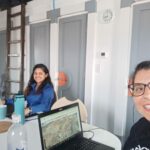
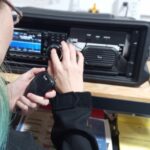
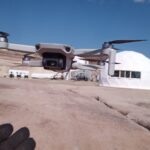
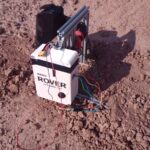


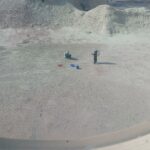





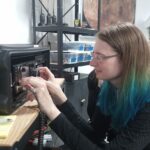
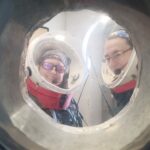

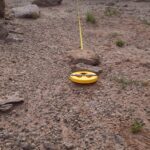
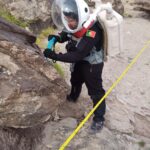

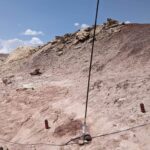
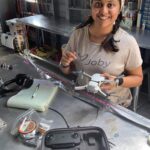
You must be logged in to post a comment.